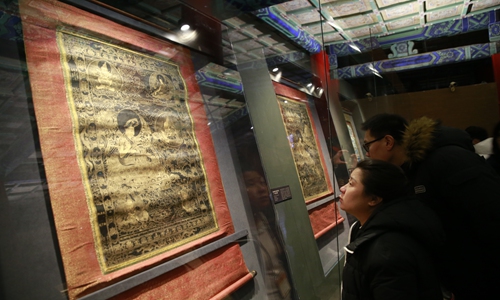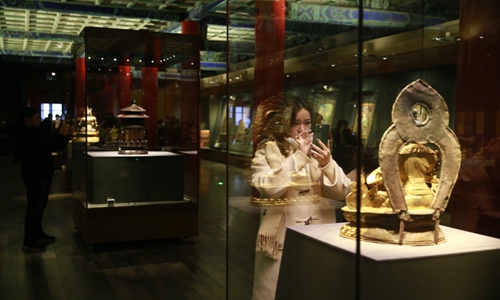HOME >> CHINA
Tibet relics at Palace Museum
By Liu Zhongyin and Zhao Yusha Source:Global Times Published: 2019/12/10 21:23:40
Rare chance to appreciate cultural, religious exchanges

Visitors appreciate scroll painting Thang-ga at the exhibition in Palace Museum on Tuesday. Photo: Li Hao/GT
Relics from the Tashi Lhunpo Monastery, successive Panchen Lamas' preaching place, traveled outside their home for the first time, and made a debut at the 600-year-old Palace Museum in Beijing, which gives visitors a rare opportunity to taste Tibetan Buddhism art and appreciate the extended cultural and religious exchanges between different ethnic groups.The exhibit, titled "the Fortune and Longevity of Sumeru: an Encounter between the Tashi Lhunpo Monastery and the Palace Museum," features cultural relics related to successive Panchen Lamas and Buddhism art. Among them, 77 pieces are from the monastery and 203 from the Palace Museum, and were opened to the public at the Palace Museum on Tuesday.
This is the first time that the museum will embrace an exhibit featuring successive Panchen Lamas' and Buddhism culture within the palace since its establishment in 1925. It is also the first time the monastery's cultural relics are traveling outside the monastery and facing the public at a museum, according to a document sent to the Global Times by the cultural heritage administration of the Tibet Autonomous Region.
Being the preaching place for successive Panchen Lamas, the monastery has kept many precious relics granted to Panchen Lamas by emperors from the Qing dynasty (1644-1911), such as the emperor's paperwork of accolade Panchen Lamas.
Some of the relics on display are tributes to emperors from other ethnic minority groups, such as the Mongols.

A visitor takes picture of relics at an exhibition, titled "the Fortune and Longevity of Sumeru: an Encounter between the Tashi Lhunpo Monastery and the Palace Museum," which opened to public on Tuesday. Photo: Li Hao/GT
The exhibit was deemed a rare opportunity by many cultural admirers to have a taste of culture of Tibetans and other ethnic minority groups.The Global Times reporter noticed on Tuesday tourists were sporadic at the Palace Museum because it is the off-season at the museum, while visitors were pouring into the exhibit. They were impressed by the fineness of the relics. Several foreigner tourists were also spotted. They said that the close ties between the central government and Tibet can be traced way back.
The exhibit is also an opener to mark the 600th anniversary of the Forbidden City, home to the Palace Museum.
The document sent by the Tibetan cultural heritage administration also said that the Tashi Lhunpo Monastery and the Palace Museum were linked together by Tibetan Buddhism and ethnic ties; the show will guide visitors in understanding the role played by Tibetan Buddhism in bolstering national solidarity.
This is a rare opportunity, because it is not easy to travel to Xigaze [where the monastery is located], said Zhang Li, who is a professor at a Beijing university. She noted that mutual understanding between people in the inland and Tibet are greatly enhanced thanks to exhibits like this.
The Tashi Lhunpo Monastery is famous for its tradition of embracing patriotism, said Zhu Weiqun, former head of the Ethnic and Religious Affairs Committee of the National Committee of the Chinese People's Political Consultative Conference.
For example, the current 11th Panchen Lama, who unwaveringly holds the flag of patriotism, comes to the monastery every year to preach to religious believers religious and patriotic content, such as how Tibet is developing under the central government's rule, Zhu said.
The exhibit ends on February 29, 2020.
Shan Jie also contributed to the story
Posted in: SOCIETY